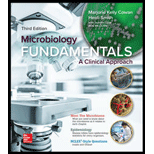
Concept explainers
A microorganism carries _____ markers and a B cell carries _____ markers.
- a. self, nonself
- b. nonself, self
- c. self, self
- d. nonself, nonself
Introduction:
The immune system evaluates cells by examining a few molecules on their surfaces termed as markers. These markers, which consist of proteins or sugars, allow the cells of the immune system to identify whether the newly discovered cell poses a threat.
Answer to Problem 1Q
Correct answer:
A microorganism carries non-self markers and a B cell carries self-markers. Therefore, option (b) is correct.
Option (b) is given as “nonself, self”.
Explanation of Solution
Justify the reasons for the correct statement:
A microorganism or any foreign particle carries nonself markers so that it can be distinguished from the native cells. B cells carry self-markers so that the immune system can differentiate between native and non-native cells.
Hence, option (b) is correct.
Justify the reasons for the incorrect statements:
Option (a) is given as “self, nonself”.
A microorganism carries nonself markers and a B cell carries self-markers. Hence, it is a wrong answer.
Option (c) is given as “self, self”.
A microorganism doesn’t carry self-markers and a B cell carries self-markers. Hence, it is a wrong answer.
Option (d) is given as “nonself, nonself”.
A microorganism carries nonself markers and a B cell does not carry nonself markers. Hence, it is a wrong answer.
Hence, options (a), (c) and (d) are incorrect.
A microorganism carries non-self-markers and a B cell carries self-markers
Want to see more full solutions like this?
Chapter 12 Solutions
Microbiology Fundamentals: A Clinical Approach
- Can you described the image? Can you explain the question as well their answer and how to get to an answer to an problem like this?arrow_forwardglg 112 mid unit assignment Identifying melting processesarrow_forwardGive only the mode of inheritance consistent with all three pedigrees and only two reasons that support this, nothing more, (it shouldn't take too long)arrow_forward
- Oarrow_forwardDescribe the principle of homeostasis.arrow_forwardExplain how the hormones of the glands listed below travel around the body to target organs and tissues : Pituitary gland Hypothalamus Thyroid Parathyroid Adrenal Pineal Pancreas(islets of langerhans) Gonads (testes and ovaries) Placentaarrow_forward
- What are the functions of the hormones produced in the glands listed below: Pituitary gland Hypothalamus Thyroid Parathyroid Adrenal Pineal Pancreas(islets of langerhans) Gonads (testes and ovaries) Placentaarrow_forwardDescribe the hormones produced in the glands listed below: Pituitary gland Hypothalamus Thyroid Parathyroid Adrenal Pineal Pancreas(islets of langerhans) Gonads (testes and ovaries) Placentaarrow_forwardPlease help me calculate drug dosage from the following information: Patient weight: 35 pounds, so 15.9 kilograms (got this by dividing 35 pounds by 2.2 kilograms) Drug dose: 0.05mg/kg Drug concentration: 2mg/mLarrow_forward
- A 25-year-old woman presents to the emergency department with a 2-day history of fever, chills, severe headache, and confusion. She recently returned from a trip to sub-Saharan Africa, where she did not take malaria prophylaxis. On examination, she is febrile (39.8°C/103.6°F) and hypotensive. Laboratory studies reveal hemoglobin of 8.0 g/dL, platelet count of 50,000/μL, and evidence of hemoglobinuria. A peripheral blood smear shows ring forms and banana-shaped gametocytes. Which of the following Plasmodium species is most likely responsible for her severe symptoms? A. Plasmodium vivax B. Plasmodium ovale C. Plasmodium malariae D. Plasmodium falciparumarrow_forwardStandard Concentration (caffeine) mg/L Absorbance Reading 10 0.322 20 0.697 40 1.535 60 2.520 80 3.100arrow_forwardPlease draw in the missing answer, thank youarrow_forward

 Human Physiology: From Cells to Systems (MindTap ...BiologyISBN:9781285866932Author:Lauralee SherwoodPublisher:Cengage Learning
Human Physiology: From Cells to Systems (MindTap ...BiologyISBN:9781285866932Author:Lauralee SherwoodPublisher:Cengage Learning Concepts of BiologyBiologyISBN:9781938168116Author:Samantha Fowler, Rebecca Roush, James WisePublisher:OpenStax College
Concepts of BiologyBiologyISBN:9781938168116Author:Samantha Fowler, Rebecca Roush, James WisePublisher:OpenStax College





